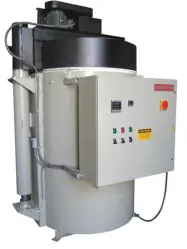Carbonizing / Pyrolysis Furnaces for Ceramic Matrix Composites (CMC)
Carbonization, or carbonizing, is the conversion of an organic substance into carbon or a carbon-containing residue through pyrolysis.
The filament for one of Thomas Edison’s early electric light bulbs was a cotton fiber thread that had been carbonized by heating it in an oxygen-free environment. For many materials, the natural product of this pyrolytic decomposition can be used as a filler or a source of carbon for a downstream process. Familiar examples include graphite flakes and coke used in the processing of metals. Modern carbonization furnaces can effectively control the end-result, material chemistry and format. Today synthetic precursor materials and fibers can be directly converted into pure carbon fibers for use in a myriad of applications.
Recent advances have yielded the ability to create multi-component composites where a large variety of inorganic materials, including carbon fibers or ceramic fibers and textiles, can be included in the composite.
This process is used to manufacture both carbon and ceramic matrix composites where the matrix and rovings are a combination of ceramics and carbon fibers. The most common material produced this way is a carbon-carbon composite. Fabrics or felts (mainly carbon or SiC) are placed on tools to give them the shape. Other fibers, including Mullite, Al-oxides and Si-carbides may be included or applied. Finally, polymer matrix materials are applied onto the rovings and placed in a carbonizing kiln or furnace where the polymers are transformed into carbon in a non-oxidizing atmosphere. During carbonization, the products of organic polymer burn out and are vented from the furnace. They can be burned in air in an exothermic reaction, which means that they can be, and frequently are, used as an additional source of energy for the thermal oxidizer which needs to match the requirements of the pyrolysis process taking place.
Since carbon reacts with air at pyrolysis temperatures, nitrogen or argon atmospheres are required in the carbonization furnace, often not allowing more than 100 ppm of oxygen in the furnace chamber which requires tight sealing of the furnace chamber.
The space industry, with its ever-growing demand for higher payloads and multiple use of the same spacecrafts, is using impregnated carbon fiber components for engines’ nozzles and on spaceship parts which are exposed to more than 1500°C during the several minutes spent reentering the earth’s atmosphere. Other applications are disks for braking systems, missile components and control systems for high speed airplanes.
The largest carbonization furnace Keith Company built was a bottom loading furnace with heating process chamber dimensions of 10 feet in diameter and 10-1/2 feet tall.
Carbonization Furnace Types
Contact Keith Company to order a carbonizing kiln or furnace for your application, or to learn more about any of our products.






